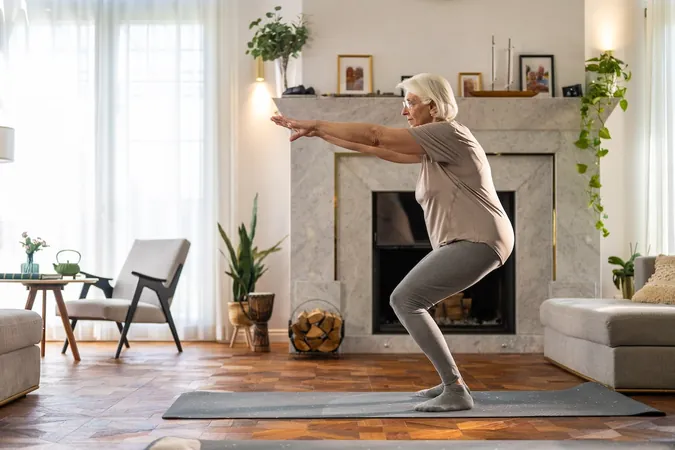
Unlock Independence: Proven Strategies to Prevent Falls as You Age
2025-06-30
Author: Michael
As you journey through life, a slip or trip in your youth may seem like a trivial mishap—perhaps just a few scrapes or a sore muscle. However, as the years roll on, the stakes rise dramatically; a fall can lead to serious injuries like fractures that take a significant time to heal.
In Canada alone, falls are the primary cause of injury-related hospitalizations and fatalities for those aged 65 and up. But here’s the good news: no matter your age, there are proactive steps you can take today to lower your risk of falling and minimize injuries if you do.
Why Do Falls Happen More Often in Older Adults?
A range of factors contribute to the increased likelihood of falls in older adults. Decreased vision, hearing impairments, and a diminished sense of body awareness—known as proprioception—play significant roles. Additionally, slower reflexes, medical conditions like diabetes that can cause dizziness, and certain medications that induce drowsiness can leave individuals vulnerable.
As we age, our muscles naturally lose strength and size, which is crucial when trying to regain balance. "Recovering from a loss of balance demands quick, explosive strength, yet our muscle power diminishes as we grow older," explains Dylan Kobsar, a kinesiology expert at McMaster University.
Fear itself can heighten fall risk. Many people become so cautious about falling that they opt out of physical activities altogether, which ironically makes them more prone to falls due to decreased muscle and balance.
Moreover, anxiety over falling can divert focus from executing complex movements. This fear not only reduces mobility but can also drastically impact one’s quality of life and independence.
Concerns about fractures and breaks from falls are amplified by age-related bone deterioration—often a silent issue known as osteoporosis. Currently, around 2.3 million Canadians deal with this condition, and one in three women and one in five men are likely to suffer a fracture due to osteoporosis during their lifetimes.
Tips to Prevent Falls and Minimize Impact
Beginning to take preventive measures now can make all the difference. Those as young as 30 should consider starting with a bone density test to establish a baseline for monitoring changes over time.
Staying active is vital. The more you avoid what you perceive as risky activities—be it walking on icy sidewalks or lifting heavy grocery bags—the harder it becomes to maintain your abilities. As you reach your thirties, you may lose muscle mass at a rate of 3% to 5% per decade. However, integrating resistance training into your routine can help combat this loss, improving balance, stability, and bone density.
To add resistance effectively, use the Reps in Reserve (RIR) method. For instance, if your goal is eight reps, choose a weight that allows you to feel comfortably challenged by the eighth rep—if it’s too easy, increase the weight; too hard, decrease it.
In addition to strength exercises, high-velocity training should be incorporated between ages 30 and 60. This includes engaged, explosive movements which enhance muscle responsiveness. After 65, focus on strengthening your lower body and improving balance through functional movements like sit-to-stands and step-ups. Simple balance drills, like standing on one leg or closing your eyes while standing, can significantly enhance stability.
"Gradual, safe progression is crucial at any age," emphasizes Kobsar. Consistency is key, and even if you feel overwhelmed, aim for strength training three times a week for 30 minutes. If that feels out of reach, start small—every bit helps.
While the ideal timeframe to start being active is before falling becomes a concern, it's never too late to begin. "That’s the wonderful aspect of exercise: it’s literally never too late to start!" remarks Fraser.









 Brasil (PT)
Brasil (PT)
 Canada (EN)
Canada (EN)
 Chile (ES)
Chile (ES)
 Česko (CS)
Česko (CS)
 대한민국 (KO)
대한민국 (KO)
 España (ES)
España (ES)
 France (FR)
France (FR)
 Hong Kong (EN)
Hong Kong (EN)
 Italia (IT)
Italia (IT)
 日本 (JA)
日本 (JA)
 Magyarország (HU)
Magyarország (HU)
 Norge (NO)
Norge (NO)
 Polska (PL)
Polska (PL)
 Schweiz (DE)
Schweiz (DE)
 Singapore (EN)
Singapore (EN)
 Sverige (SV)
Sverige (SV)
 Suomi (FI)
Suomi (FI)
 Türkiye (TR)
Türkiye (TR)
 الإمارات العربية المتحدة (AR)
الإمارات العربية المتحدة (AR)